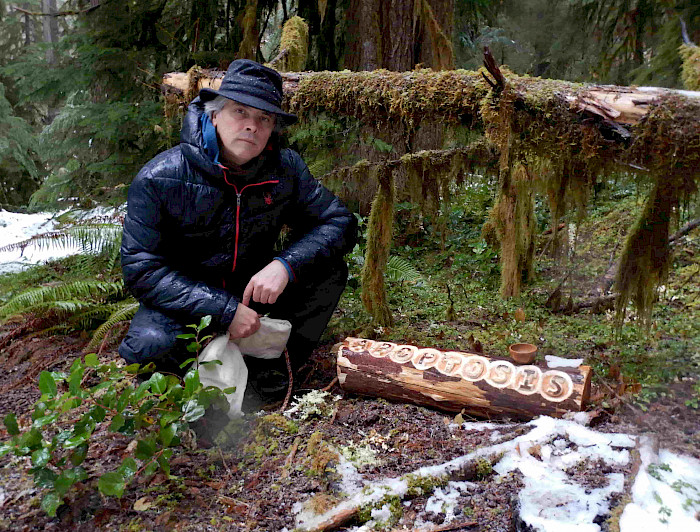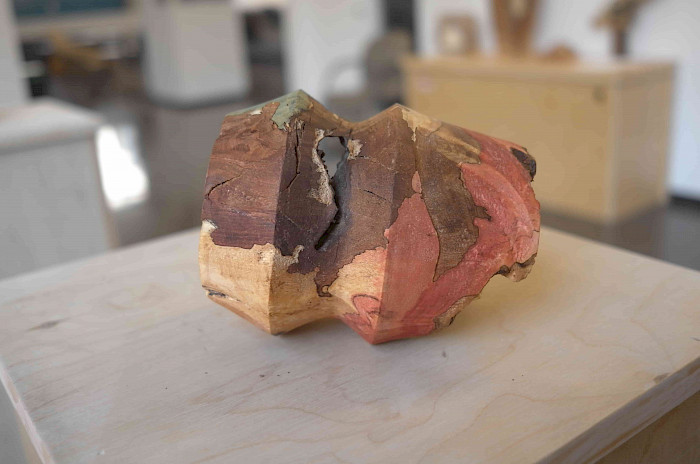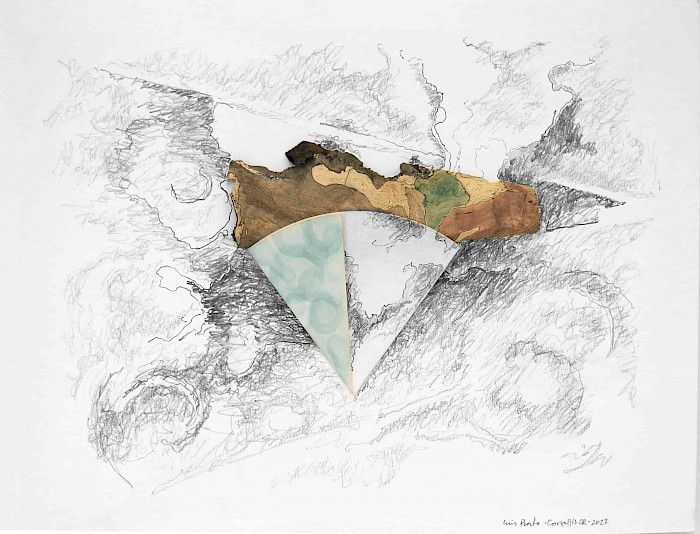A Journey into the Heart of Wood at Oregon State University
Luis Prato, a professor from the School of Arts, embarked on a captivating research residency in the Department of Wood Science and Engineering at Oregon State University. During this period, he worked in a specialized laboratory focused on extracting pigments from fungi and participated in a workshop exploring woodturning techniques for decaying wood.

photo_camera Luis Prato at the H.J. Andrews Experimental Forest, next to his project, Apoptosis (2022). Photo courtesy of the artist.
A pivotal moment in Professor Luis Prato's career unfolded in 2018 when he was invited to participate in a workshop at the Universidad Austral de Chile, in Valdivia. The workshop, titled "Contemporary Uses of Wood: Mushroom Pigmentation in Color Process," was led by Oregon State University professor and bio-artist, Seri Robinson. Surrounded by craftsmen, forestry engineers, and forest scientists, Luis felt compelled to reconnect with wood, a material rooted in the origins of his work as a sculptor.
With the aim of gaining a fresh perspective, Luis Prato pursued an academic residency in Oregon State University’s Department of Wood Science and Engineering. “Here, there is a firm belief that forestry engineers thrive in their chosen domains of expertise, achieving optimal performance when they are enriched with aesthetic experiences in wood creation, spanning across both design and artistic spheres.”

Why Forestry Engineering over Design or Artistic Creation in Wood?
—My interest in forestry was driven by a desire to be in an environment where wood is viewed from a completely different perspective. I aimed to explore an aspect of wood I was previously unfamiliar with, namely its decomposition processes. In Chile, decomposed wood is often deemed useless even for firewood. While we adore flawless, knot-free wood commercially and artistically, what happens to the seemingly useless wood? How do fungi color wood in ways and time frames beyond my control? Oregon provided the scientific insights I sought, guiding me on how to cultivate fungus on wood or substrate to extract these pigments.
Luis Prato specifically refers to spalting, a fungal pigmentation technique that imbues wood with various colors and textures. “Understanding the transformative effects of fungi on wood is not just having the information; it involves grasping processes that reveal alternative ways of existing in the world—agencies independent of my words, imagination, or conceptualization," said Luis Prato.
Throughout his residency, Luis also honed his skills as a lathe operator. "The lathe is almost a parallel discipline to carpentry (...) What happens here is that to work on a lathe you need a physical apprenticeship that the other tools do not require," he explained about the need for specific training in this trade.
Apoptosis
Inspired by his experience in the US, Luis Prato created two exhibitions. The first, named “Apoptosis”, draws its meaning from the Greek word used in embryology to denote the moment when cells undergo programmed cell death to support the body’s formation. The exhibition featured turned wood, spalted wood, drawings, sculptures, photographs, and videos, providing a comprehensive exploration of his artistic endeavors during the residency.
Additionally, Luis materialized this concept in a piece of wood gifted to him by senior researcher Fred Swanson of the H.J. Andrews Experimental Forest, a research station in the State of Oregon. “For nearly three decades, they’ve extended invitations to artists in the field of literature, hosting poets and writers for residencies. On rare occasions, they’ve also included visual artists. Upon my arrival, Swanson welcomed me saying: ‘What we anticipate from you, as an artist, is a collaborative exploration, fostering shared thoughts, dialogue, and the contribution of alternative perspectives— distinct ways of envisioning, imbuing meaning, and contemplating the forest from a sensitive viewpoint, a perspective seldom nurtured by scientists,” he recalled.
The second exhibition showcased Luis Prato’s drawings for the first time. “It was an unplanned revelation, emerging from observation and the need to translate visually what I was experiencing through my hands,” he reflected. The reception was overwhelmingly positive, with scientists expressing genuine excitement about the sensitive handling of materials they had researched and the possibility of buying the art, something the sculptor had not considered.



